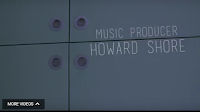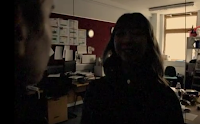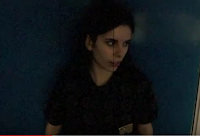Madison Brownlow AS Media Coursework
Tuesday, 18 April 2017
Evaluation Question 1 & 5
A script was wrote by all of us. We wrote the parts that we were going to speak, with small improvements as we found necessary. We thought it was important to maintain eye contact with the camera as we were talking to make it feel genuine, and to make it a lot less boring that staring at a piece of paper the entire time.
Monday, 17 April 2017
Evaluation Question 3
What kind of media institution might distribute your media product and why?
Women's Bane Distribution PowerPoint from Madison Brownlow
The PowerPoints (question 2&3) were created as a group, with all of us discussing and giving ideas whilst the PowerPoint was being produced.
The PowerPoints (question 2&3) were created as a group, with all of us discussing and giving ideas whilst the PowerPoint was being produced.
Evaluation Question 4
Who would be the audience for your media product?
Tuesday, 18 April 2017
Evaluation Essay 07
Looking back at your preliminary task, what do you feel have learnt in the progression from it to the full product?
As the group's editor, I have had to learn how to use Final Cut Pro. Whilst I had experience using some editing programs, I am not used to the Mac interface. When we was making the continuity sequence, I struggled to understand the interface of Final Cut Pro; I felt like everything was hidden and it was difficult to navigate. However, once I got over the first hurdle of getting used to Final Cut Pro I found it quick and accessible, making editing fast. Final Cut Pro made it fast to put text, effects, music and to cut down the footage together and simple. It was also easy to replace and remove, and make our film work.
I was first introduced to Final Cut Pro when editing the preliminary sequence. Looking back on the footage now, it was not hard to edit - there were simple cuts the whole way through, with a blackout scene at the end, there was only one track used for the music and one sound effect at the end. However, since I was new to Final Cut Pro, it took a long time. Getting things into sequence were not hard, but adding effects were. I remember being frustrated at how unclear Final cut felt to me, with no guidance being given at all. I however got over it very quickly, and googled how to add sound effects, video effects and cutting worked, leading to the preliminary sequence to become what it is today. The media technician also did a workshop on how to use Final Cut Pro, which helped.
I was first introduced to Final Cut Pro when editing the preliminary sequence. Looking back on the footage now, it was not hard to edit - there were simple cuts the whole way through, with a blackout scene at the end, there was only one track used for the music and one sound effect at the end. However, since I was new to Final Cut Pro, it took a long time. Getting things into sequence were not hard, but adding effects were. I remember being frustrated at how unclear Final cut felt to me, with no guidance being given at all. I however got over it very quickly, and googled how to add sound effects, video effects and cutting worked, leading to the preliminary sequence to become what it is today. The media technician also did a workshop on how to use Final Cut Pro, which helped.
We used DSLRs to film our footage for the title sequence. Whilst they aren’t cameras designed for filming, they worked well with their portability and their ability to be handheld. Whilst we did face some difficulties with the aperture of the camera and lack of stability if we wanted some close up shots, we did learn that the camera had a lot of potential to film in awkward positions. We used the DSLRs for both our continuity sequence and our final title sequence, and they worked well. The footage was also easy to put onto a computer, which allowed us to work fast. With the tripod attached to the DSLR, we could get the desired height in many of our shots, making many of our shots clean and crisp.
For the white screen shots, we used a variety of technology to help us. These include softbox lights and a white screen. The softbox lights provided us a clean look, and helped the contrast of the black and white in editing, with the softbox lights washing out any stains that might be on the white screen. The white screen scenes help build a story, and I think if we had shot those scenes on a coloured or patterned wall the narrative wouldn’t be as strong, and the focus on the female lead wouldn’t be as strong. In our continuity sequence, we used phone lights to light up the dark scene in the staffroom. This did work well, because we wanted the scene to be dark to portray the horror genre. But since for the title sequence we were following the same high-key lighting seen in American Psycho, we needed the softbox lights to help us keep with that theme. We also didn’t have to use the white screen in our continuity sequence as it didn’t fit in with our narrative.
To conclude, whilst all the equipment we used may have appeared intimidating at first, it was actually easy, and didn’t take long to learn at all. Everything was easy to setup and use how we wanted, which resulted in filming and editing being swift and rather simple. I certainly have learnt a lot since our continuity sequence with the introduction of new technology and equipment, but nothing was overly challenging or so hard that we had to scrap using it. I am satisfied with the progress we have made since our continuity sequence.
Evaluation 06: Use of technologies
These soundcloud recordings were made as a group. We all collectively met over the break and recorded it using audacity with a headset microphone surrounding us. We all worked on the script together, collaborating on the parts that they spoke. It was also relatively easy to edit, with the automated voice speaking the question at the start and amplifying our speech slightly.
Evaluation 04: Audience of our media product
The soundcloud recordings were made as a group. We all met over the break and recorded it using audacity with a headset microphone surrounding us. We all worked on the script together, collaborating on the parts that they spoke, with slight changes made to make the recording more coherent.
Evaluation Question 6
What have you learnt about technologies from the process of constructing this product?
Evaluation Question 7
Looking back at your preliminary task, what do you feel like you have learnt in the progression from it to the full product?

As the groups cinematographer, I worked with DSLRS - which was a new experience for me. However, throughout the process it made me more aware of everything's position in the frame; what should be and should not be included. This became highly important as the placing of everything affected how the credits would be placed later. Although the cinematography turned out relatively successful - there was still some struggles on my behalf and technical issues that hindered our results. The tapping scene, for example, was quite difficult to film, this is because of the angle the hand comes from - and our intention was to make it look like a PoV shot. However, due to us wanting to keep the close-up theme for the white screen scenes the shot did not work, making the performance seem awkward and robotic. DSLRS aren't cameras specially for designed filming such as a RED Epic, but they provided relatively successful results. But as mentioned before, there were technical issues. These issues followed from the continuity sequence, when, we struggled to capture the close up of the phone - as the camera would go out of focus if we go too close. This also happened during our filming for the poison scene - we wanted an extreme close up, but again, the camera would go out of focus. We learnt to work around these issues.

 Filming the continuity sequence was hard for me, as i was new to it and wasn't use to a DSLR. However, it went surprisingly well - i was able to frame shots to create an atmosphere. Which is seen in the bottom screenshot, as by doing a slight high-angle shot it made Maddie's character look small and weak. This added to the tension of our sequence.There were a few techniques used in the preliminary task that helped develop my skill and made the filming of Women's Bane easier. For example the tack shot up Kelly's body and the slight pov over the shoulder shots, helped me to figure out positioning in the frame. Panning and shot-reverse-shots helped to establish character relations - which would be important between our protagonist and her victim.
Filming the continuity sequence was hard for me, as i was new to it and wasn't use to a DSLR. However, it went surprisingly well - i was able to frame shots to create an atmosphere. Which is seen in the bottom screenshot, as by doing a slight high-angle shot it made Maddie's character look small and weak. This added to the tension of our sequence.There were a few techniques used in the preliminary task that helped develop my skill and made the filming of Women's Bane easier. For example the tack shot up Kelly's body and the slight pov over the shoulder shots, helped me to figure out positioning in the frame. Panning and shot-reverse-shots helped to establish character relations - which would be important between our protagonist and her victim.We also used various technologies such as soft-box lighting, white screen, a tripod and steady cam. We did not use these technologies in our continuity sequence, as we had a limited amount of time to film it. Softbox lights and the white screen were used for the scenes edited in black and white, they helped to create the high-key lighting we desired and also contributed to the high contrast that made the black and white scenes successful. From this, we learned how vital lighting was, and how it could change the atmosphere. The white screen helped build the story and to separate parts of the narrative, as if the walls were coloured for all the scenes - the coloured scenes would lose their effectiveness. For our continuity sequence, we used our phones to light up our location, and while this did provide the dark lighting we were after - it made everything very grainy.
Overall, the equipment helped our group grow and produce the title sequence we desired. Everything was easy to set up and simple to use, resulting in our swift completion of the title sequence.
Saturday, 15 April 2017
Subscribe to:
Comments (Atom)
Evaluation Question 1 & 5
A script was wrote by all of us. We wrote the parts that we were going to speak, with small improvements as we found necessary. We thought...

-
A script was wrote by all of us. We wrote the parts that we were going to speak, with small improvements as we found necessary. We thought...
-
Todorov's Narrative Theory T odorov's narrative theory suggests that all narratives follow a three part structure where...
-
After talking with our teacher, we have completely changed the death scene. Instead of it being shot in a bar (or a setup to look like a ...
